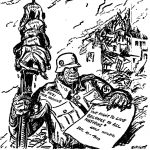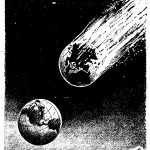The Case for Intervention
For eight full months after France and Britain declared war on Germany in September 1939, all three nations hesitated, unwilling to launch a full-scale offensive. While some mocked it as the “Phoney War,” most correctly perceived that the combatants were playing for time, building supplies and armaments for the inevitable clash.
This gave time for the debate in America to play out in largely abstract terms: what role would America need to play in the coming war? Or, to reframe the question in terms more amenable to isolationism, what role should American play? Should we avoid becoming entangled in yet another of Europe’s endless wars? Should we supply armaments to our longtime ally? Should we drop everything and fight?
For homework today we’ll be examining an essay, several political cartoons, and two superhero comics that make the case, in one way or another, for intervention. Read all five of them, then write a concise response to one of the following prompts:
- Rear Admiral Yates Stirling wrote an essay advocating support for Great Britain—one of three essays published in the Nov 1939 issue of Forum and Century debating the neutrality question. Thinking back to Lindbergh’s Sep 1939 radio address, what principle(s) does Stirling appeal to? On balance is he more or less of an idealist than Lindbergh?
- Jerry Siegel and Joe Shuster, creators of Superman, published their thoughts on war in a short strip that ran in the Feb 27, 1940, issue of Look magazine. According to comic-book lore, their editor at Detective Comics wouldn’t allow such an explicitly political story. But what, exactly, is the message here? In telling “How Superman Would Win the War,” what were Siegel and Shuster saying about what America should do? In answering this question, take note of how the comic mixes a fictional fantasy hero with two real-life villains.
- After the real fighting broke out in May, 1940, the tone of the debate over intervention shifted somewhat, as witness the two political cartoons below. Responding to one or or the other cartoon, what principle(s) does it appeal to? On balance is it more or less of idealistic than Lindbergh?
- Walter Enright, Dec 1940
- Bruce Russell, Jan 1941
- In Mar, 1941, artist Jack Kirby premiered a new hero, Captain America, co-created with writer Stan Lee and published by Timely Comics (rebranded “Marvel Comics” in the late 1950s). Based solely on the comic’s cover, what’s Kirby’s argument for American intervention? Is his fantasy any different in its political implications from Siegel and Shuster’s Superman comic, above?


